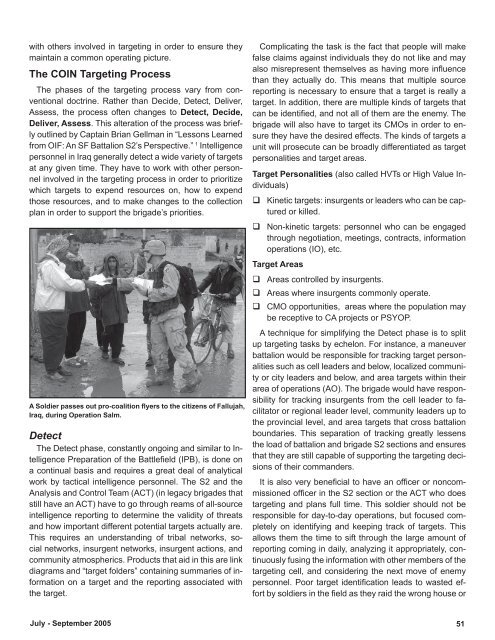Military Intelligence Professional Bulletin - Federation of American ...
Military Intelligence Professional Bulletin - Federation of American ...
Military Intelligence Professional Bulletin - Federation of American ...
Create successful ePaper yourself
Turn your PDF publications into a flip-book with our unique Google optimized e-Paper software.
with others involved in targeting in order to ensure they<br />
maintain a common operating picture.<br />
The COIN Targeting Process<br />
The phases <strong>of</strong> the targeting process vary from conventional<br />
doctrine. Rather than Decide, Detect, Deliver,<br />
Assess, the process <strong>of</strong>ten changes to Detect, Decide,<br />
Deliver, Assess. This alteration <strong>of</strong> the process was briefly<br />
outlined by Captain Brian Gellman in “Lessons Learned<br />
from OIF: An SF Battalion S2’s Perspective.” 1 <strong>Intelligence</strong><br />
personnel in Iraq generally detect a wide variety <strong>of</strong> targets<br />
at any given time. They have to work with other personnel<br />
involved in the targeting process in order to prioritize<br />
which targets to expend resources on, how to expend<br />
those resources, and to make changes to the collection<br />
plan in order to support the brigade’s priorities.<br />
A Soldier passes out pro-coalition flyers to the citizens <strong>of</strong> Fallujah,<br />
Iraq, during Operation Salm.<br />
Detect<br />
The Detect phase, constantly ongoing and similar to <strong>Intelligence</strong><br />
Preparation <strong>of</strong> the Battlefield (IPB), is done on<br />
a continual basis and requires a great deal <strong>of</strong> analytical<br />
work by tactical intelligence personnel. The S2 and the<br />
Analysis and Control Team (ACT) (in legacy brigades that<br />
still have an ACT) have to go through reams <strong>of</strong> all-source<br />
intelligence reporting to determine the validity <strong>of</strong> threats<br />
and how important different potential targets actually are.<br />
This requires an understanding <strong>of</strong> tribal networks, social<br />
networks, insurgent networks, insurgent actions, and<br />
community atmospherics. Products that aid in this are link<br />
diagrams and “target folders” containing summaries <strong>of</strong> information<br />
on a target and the reporting associated with<br />
the target.<br />
Complicating the task is the fact that people will make<br />
false claims against individuals they do not like and may<br />
also misrepresent themselves as having more influence<br />
than they actually do. This means that multiple source<br />
reporting is necessary to ensure that a target is really a<br />
target. In addition, there are multiple kinds <strong>of</strong> targets that<br />
can be identified, and not all <strong>of</strong> them are the enemy. The<br />
brigade will also have to target its CMOs in order to ensure<br />
they have the desired effects. The kinds <strong>of</strong> targets a<br />
unit will prosecute can be broadly differentiated as target<br />
personalities and target areas.<br />
Target Personalities (also called HVTs or High Value Individuals)<br />
� Kinetic targets: insurgents or leaders who can be captured<br />
or killed.<br />
Non-kinetic targets: personnel who can be engaged<br />
through negotiation, meetings, contracts, information<br />
operations (IO), etc.<br />
Target Areas<br />
A technique for simplifying the Detect phase is to split<br />
up targeting tasks by echelon. For instance, a maneuver<br />
battalion would be responsible for tracking target personalities<br />
such as cell leaders and below, localized community<br />
or city leaders and below, and area targets within their<br />
area <strong>of</strong> operations (AO). The brigade would have responsibility<br />
for tracking insurgents from the cell leader to facilitator<br />
or regional leader level, community leaders up to<br />
the provincial level, and area targets that cross battalion<br />
boundaries. This separation <strong>of</strong> tracking greatly lessens<br />
the load <strong>of</strong> battalion and brigade S2 sections and ensures<br />
that they are still capable <strong>of</strong> supporting the targeting decisions<br />
<strong>of</strong> their commanders.<br />
It is also very beneficial to have an <strong>of</strong>ficer or noncommissioned<br />
<strong>of</strong>ficer in the S2 section or the ACT who does<br />
targeting and plans full time. This soldier should not be<br />
responsible for day-to-day operations, but focused completely<br />
on identifying and keeping track <strong>of</strong> targets. This<br />
allows them the time to sift through the large amount <strong>of</strong><br />
reporting coming in daily, analyzing it appropriately, continuously<br />
fusing the information with other members <strong>of</strong> the<br />
targeting cell, and considering the next move <strong>of</strong> enemy<br />
personnel. Poor target identification leads to wasted effort<br />
by soldiers in the field as they raid the wrong house or<br />
July - September 2005 51<br />
�<br />
� Areas controlled by insurgents.<br />
� Areas where insurgents commonly operate.<br />
� CMO opportunities, areas where the population may<br />
be receptive to CA projects or PSYOP.
















